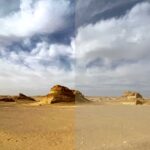Welcome to Aokigahara, a place where ethereal landscapes meet a somber history. Known for its haunting beauty, this enigmatic forest at the base of Mount Fuji captivates and mystifies. Join us as we explore Aokigahara’s natural wonders, delve into the complexities of its past, and navigate the delicate balance between tragedy and hope that defines this unique location.
Capturing Aokigahara’s Essence: A Photographer’s Paradise
Aokigahara Forest, with its serene atmosphere and captivating beauty, draws photographers from around the globe. Stepping into this forest is like entering another world, where the trees, moss, and light filtering through the leaves create a surreal and otherworldly ambiance.
A Visual Tapestry of Wonder
Photographs of Aokigahara are incredibly diverse. Sweeping landscapes evoke a sense of awe and make you feel insignificant against the backdrop of nature’s grandeur. Close-ups reveal the intricate details of strange plants, vibrant flowers, and textures unseen in other forests. Historical images offer a glimpse into Aokigahara’s past, allowing us to piece together the story of this complex and ever-evolving landscape.
However, the act of photography in Aokigahara comes with a responsibility. While capturing its beauty, it’s crucial to remember the forest’s tragic history and approach it with sensitivity and respect.
A Landscape Shaped by Nature and Legend
The Aokigahara we see today was born from the fiery heart of Mount Fuji. Centuries ago, lava flowed down the slopes, cooling and solidifying over time. In this hardened lava, life found a foothold, and trees began to take root, creating a unique ecosystem unlike any other.
Adding to the mystery are ancient legends, such as the tale of “Ubasute.” This heart-wrenching story suggests that during times of famine, families may have abandoned their elderly in Aokigahara. While there’s no historical evidence to support this practice actually occurring, the legend continues to color perceptions of the forest, connecting it to themes of abandonment and sorrow.
Literature, too, has played a significant role in shaping Aokigahara’s image. Seichō Matsumoto’s novel “Tower of Waves,” which uses the forest’s somber atmosphere to tell a story of loss and despair, further cemented Aokigahara’s association with profound sadness.
Facing a Difficult Reality with Empathy
Aokigahara’s connection to suicide is undeniable and must be addressed with sensitivity, choosing empathy over sensationalism. If this aspect is included in photography, it’s imperative to do so responsibly, focusing on human stories and providing resources for mental health support. You can find more information and resources at The Suicide Prevention Lifeline.
Discovering Aokigahara Through Images
Aokigahara’s allure can be experienced through photography. Here are some resources to begin your exploration:
- Stock Photo Agencies: Websites like Getty Images and Shutterstock offer a vast collection of professional Aokigahara photographs, each capturing a unique perspective.
- Free Image Platforms: Unsplash is an excellent resource for free-to-use Aokigahara images, providing a diverse range of perspectives.
- National Geographic: Tomasz Lazar’s article, “An Ethereal Forest Where Japanese Commit Suicide,” pairs stunning photography with an exploration of the forest’s environmental and emotional landscape.
Shifting Perspectives: A Future of Hope and Understanding
There’s so much more to uncover about Aokigahara, and that includes shifting our perspective. Imagine a future where we focus on:
- Conservation Efforts: Highlighting the tireless work of individuals battling to preserve Aokigahara’s unique ecosystem.
- Local Voices: Sharing the stories of those living near the forest and their efforts to change the narrative surrounding Aokigahara.
- Photographer’s Journeys: Hearing from photographers about their personal experiences capturing the essence of Aokigahara with sensitivity and respect.
By approaching Aokigahara with an open mind, sensitivity, and a thirst for understanding, we can move beyond the surface and appreciate its beauty, sorrow, and the ongoing efforts to protect this unique place.
Hutan Aokigahara: What is it Known For?
Aokigahara, often referred to as the “Suicide Forest,” carries a weighty reputation. This name, while evoking a sense of mystery and intrigue, also points towards a tragic reality. Over the years, Aokigahara has been the site of numerous suicides, contributing to its somber and unsettling image. The forest’s serene beauty, characterized by towering trees, a hushed silence, and an ethereal quality, stands in stark contrast to its association with death.
Several factors have contributed to Aokigahara’s reputation. One theory links it to the ancient Japanese practice of “ubasute” — the act of abandoning elderly family members in remote locations. However, there’s no concrete historical evidence to suggest that “ubasute” ever took place in Aokigahara.
Literary works, such as Seicho Matsumoto’s novel “Tower of Waves,” have also played a role in solidifying Aokigahara’s image as a place of despair. The novel, which depicts a tragic love suicide within the forest, captured public imagination and further intertwined Aokigahara with themes of death and sorrow.
However, reducing Aokigahara solely to its association with suicide overlooks the forest’s multifaceted nature. Formed by the cooling lava flows of Mount Fuji centuries ago, Aokigahara possesses a unique and captivating beauty. The play of light through the dense canopy, the stillness of the air, and the unusual flora and fauna make it a place of undeniable natural wonder.
Recognizing the seriousness of Aokigahara’s association with suicide, Japanese authorities have implemented measures to promote life and hope within the forest:
- Patrolling the Forest: Police officers and volunteers regularly patrol Aokigahara, looking for and offering assistance to individuals who might be at risk.
- Signs of Hope: Messages of hope and support, along with suicide prevention hotline numbers, are strategically placed throughout the forest, offering a lifeline to those who may be struggling.
- Surveillance Systems: Some areas of the forest are equipped with CCTV cameras to enhance safety and aid in prevention efforts.
Beyond these measures, NGOs and mental health organizations are working tirelessly to provide support and resources to individuals struggling with suicidal thoughts. These efforts aim to create an environment where people feel empowered to seek help and to challenge the perception of Aokigahara as a place of despair. If you or someone you know needs help, please reach out to the resources mentioned above or visit The American Foundation for Suicide Prevention for more information and support.
While Aokigahara’s reputation as the “Suicide Forest” persists, it’s crucial to acknowledge the ongoing efforts to reclaim the narrative and promote life and hope. By combining prevention initiatives with public awareness and an appreciation for the forest’s natural beauty, there’s hope that Aokigahara will eventually be known more for its tranquility and wonder than for its tragedy.
Aokigahara’s Size: A Sea of Trees
Imagine a forest spanning the size of nearly 7,400 football fields. That’s the scale of Aokigahara, a sprawling woodland encompassing approximately 30 square kilometers at the foot of Mount Fuji. But Aokigahara is no ordinary forest. Its densely packed trees, forming a thick canopy that blocks out the sun, create a hushed and somewhat eerie atmosphere.
The forest floor is equally unique. It’s formed from hardened lava, a testament to Mount Fuji’s eruptions centuries ago. Imagine walking on ground that was once molten rock! Even sound behaves differently in Aokigahara. A strange stillness permeates the air, with only the rustling of leaves and the whisper of wind breaking the silence. This unusual acoustic quality has earned the forest the nickname “Sea of Trees.”
Some geologists believe that Aokigahara’s dense, rocky, volcanic soil could be the reason behind the muted soundscape. This theory adds another layer of intrigue to this enigmatic forest. While further research is needed to fully understand Aokigahara’s unique acoustics, one thing is certain: visiting this forest is like stepping into a different world, a world of hushed serenity and captivating beauty at the base of a magnificent volcano.
Interested in exploring other fascinating and challenging environments? Join us on our apocalypse slough to discuss survival in a post-apocalyptic world. Or, if you’re in the mood for deep conversations over drinks, check out our aperitif ouzo smell forum.
















1 thought on “Aokigahara Photos: A Visual Journey Through Beauty, Tragedy, and Shifting Perspectives”
Comments are closed.